The National WWII Museum
The National WWII Museum, formerly known as The National D-Day Museum, is a military history museum located in the Central Business District of New Orleans, Louisiana, USA, on Andrew Higgins Drive between Camp Street and Magazine Street. The museum focuses on the contribution made by the United States to Allied victory in World War II. Founded in 2000, it was later designated by the U.S. Congress as America's official National WWII Museum in 2003.[2] The museum is a Smithsonian Institution affiliated museum.[3] The mission statement of the museum emphasizes the American experience in World War II.[4]
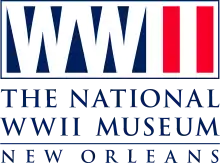 | |
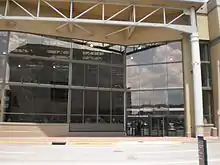 Main Entrance | |
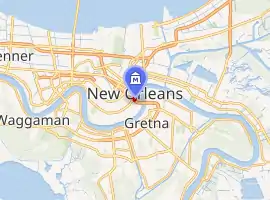
| |
| Established | June 6, 2000 |
|---|---|
| Location | New Orleans, Louisiana, United States |
| Type | Military history museum |
| Visitors | 706,664 (2017)[1] |
| Website | www |
History
The museum opened as the D-Day Museum, on June 6, 2000, the 56th anniversary of D-Day, focusing on the amphibious invasion of Normandy. As the Higgins boats, vital to amphibious operations, were designed, built, and tested in New Orleans by Higgins Industries, the city was the natural home for such a project. Furthermore, New Orleans was the home of historian and author Stephen Ambrose, who spearheaded the effort to build the museum. Ambrose also wrote a book entitled D-Day in 1994, which describes the planning and execution of Operation Neptune, which was launched on June 6, 1944.
Museum description
In addition to opening a second gallery exploring the amphibious invasions of the Pacific War in the original building, known as the Louisiana Memorial Pavilion, the museum has since opened the Solomon Victory Theater, the John E. Kushner Restoration Pavilion, the US Freedom Pavilion: The Boeing Center, and the Campaigns of Courage pavilion. There are further plans to construct what will be called the Liberation Pavilion.[5]
Within the large atrium of the Louisiana Memorial Pavilion several aircraft are on display, including a Supermarine Spitfire and a Douglas C-47 Skytrain suspended from the ceiling. A LCVP, or "Higgins boat," is also usually on display in this pavilion. The exhibits in this pavilion focus on the amphibious landings in the European theater of the war and on the contributions of the home front. The Louisiana Memorial Pavilion is also home to rotating temporary exhibits, as well as the immersive and interactive train car (part of the larger "Dog Tag Experience" interactive), which opened in 2013.
This part of the museum includes several permanent galleries, including the Home Front, Planning for D-Day, and the D-Day Beaches. The third floor of the Louisiana Memorial Pavilion includes an observation deck for closer viewing of the hanging aircraft.
In January 2013, the museum opened the US Freedom Pavilion: The Boeing Center, which is the now largest building on the campus.[6] The collection in the US Freedom Pavilion includes a B-17E Flying Fortress bomber, a B-25J Mitchell bomber, an SBD-3 Dauntless, a TBF Avenger, a P-51D Mustang, Corsair F4U-4 and an interactive submarine experience based on the final mission of the USS Tang.[6] The B-17E is the airplane dubbed My Gal Sal, famous for having been lost over Greenland and recovered 53 years later.[6] The US Freedom Pavilion was paid for with a $15 million donation from the Boeing Company and with a $20 million grant from the US Department of Defense with congressional approval.[7]
In December 2014, the museum opened the Road to Berlin portion of the Campaigns of Courage pavilion, focusing on the European theater of war. A Messerschmitt Bf 109 hangs in the building. The Road to Tokyo portion of this same pavilion, which focuses on the Pacific war, opened in 2015.[8] The entire pavilion, including both galleries, measures 32,000 square feet.[9]
In June 2017, a new exhibit, The Arsenal of Democracy, opened in the Louisiana Memorial Pavilion, dealing the experience on the Home Front. [10]
The museum also has plans to open what will be called the Liberation Pavilion by 2020. Its goal would be to explore the "joys, costs, and meaning of liberation and freedom," as well as how the legacy of World War II affects us today.[11]
Visitors to the museum are encouraged to allocate roughly 2½ to 3 hours to tour the museum. An award-winning 4-D film, Beyond All Boundaries, is shown in the Solomon Victory Theater and gives the visitor an overview of the war on every front. Other multimedia displays are integrated into most of the museum's exhibits, notably the dozens of video oral histories conducted with veterans of the war by museum staff. The museum currently houses two restaurants, the American Sector Restaurant & Bar and the Soda Shop.
The museum sponsors a wargaming club and holds a wargame convention each year called "Heat of Battle".[12]
The museum also hosts a World War II-themed quiz bowl tournament, which is televised on Cox 4 New Orleans.
Relation to New Orleans
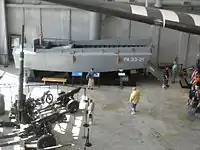
The museum closed for three months after Hurricane Katrina ravaged New Orleans on August 29, 2005, re-opening on December 3 of that year. A museum banner promoted the re-opening by proclaiming "We Have Returned," a phrase made famous by General Douglas MacArthur regarding his eventual return to the Philippines in 1944.
As of 2015, the museum is in the midst of a $400 million capital expansion campaign[13] called The Road to Victory: A Vision for Future Generations. The expansion has resulted in significant increases in attendance.[14] The Solomon Victory Theater, Stage Door Canteen, and American Sector restaurant opened in November 2009. The John E. Kushner Restoration Pavilion opened in June 2011.[15][16][17] The US Freedom Pavilion: The Boeing Center opened to the public in 2013, followed by the opening of the first phase of the Campaigns of Courage pavilion in 2014. The second phase of the Campaigns of Courage Pavilion, Road to Tokyo, opened in 2015.[8] The final project in the expansion will be the Liberation Pavilion. Initially, the intended date of completion of the expansion project was 2015, but ground has not yet been broken on the final pavilion.
Visitation at the museum continues to grow, with 406,251 in 2010[18] having grown to nearly 700,000 in fiscal year 2016.[13]
Gallery
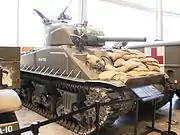
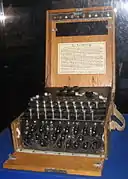 Enigma machine on display
Enigma machine on display Norden bombsight on display
Norden bombsight on display Higgins boat (LCVP) display
Higgins boat (LCVP) display The Louisiana Memorial Pavilion as seen from Camp St. at Andrew Higgins Dr.
The Louisiana Memorial Pavilion as seen from Camp St. at Andrew Higgins Dr. Entrance to the Solomon Victory Theatre
Entrance to the Solomon Victory Theatre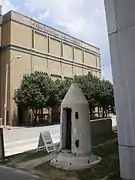 Air raid shelter in front of museum
Air raid shelter in front of museum Portion of the Atlantic Wall on the museum's campus
Portion of the Atlantic Wall on the museum's campus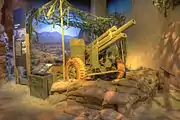 M2A1 display
M2A1 display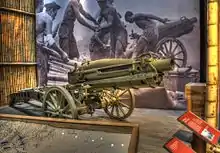 75 mm pack howitzer M1A1
75 mm pack howitzer M1A1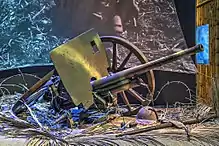
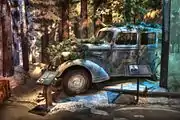 1934 Opel sedan in winter camouflage
1934 Opel sedan in winter camouflage
Airplanes
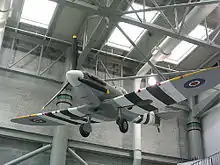 Spitfire fighter plane
Spitfire fighter plane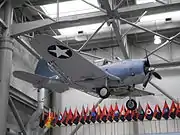 Dauntless dive bomber
Dauntless dive bomber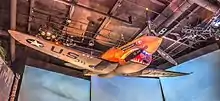
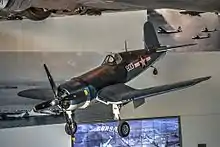
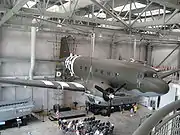 A C-47 on display in the museum atrium
A C-47 on display in the museum atrium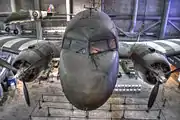 detail of C-47
detail of C-47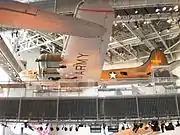 B-17 in the US Freedom Pavilion: The Boeing Center
B-17 in the US Freedom Pavilion: The Boeing Center
See also
- American Heritage Museum - Stow, Massachusetts
- Imperial War Museum - London, England
- The International Museum of World War II - Natick, Massachusetts (closed in September 2019)
- Marine Corps War Memorial - Arlington County, Virginia
- Museum of La Coupole - German-built V-2 launch site in Pas-de-Calais, France
- Museum of the War of Chinese People's Resistance Against Japanese Aggression - Beijing, China
- Museum of the Great Patriotic War, Moscow - Poklonnaya Gora, Moscow, Russia
- Museum of the Second World War - Gdańsk, Poland
- National D-Day Memorial - Bedford, Virginia
- National Museum of the History of Ukraine in the Second World War - Kiev, Ukraine
- National Museum of the Pacific War - in home of Fleet Admiral Chester Nimitz in Fredericksburg, Texas
- National World War I Museum and Memorial - Kansas City, Missouri
- United States Holocaust Memorial Museum - National Mall, Washington, DC
- World War II Memorial - National Mall, Washington, DC
References
- "The National WWII Museum Sets Visitation Records". National World War II Museum press releases. Retrieved May 24, 2015.
- Roberts, Deon (September 22, 2005). "D-Day Museum in New Orleans plans expansion" (PDF). New Orleans CityBusiness. Archived (PDF) from the original on September 10, 2016.
- "Affiliate Profile - National World War II Museum". Smithsonian Affiliations. Retrieved July 12, 2020.
- "Mission / Vision / Values - The National WWII Museum - New Orleans". The National WWII Museum - New Orleans. Retrieved November 12, 2018.
- "Upcoming Projects - The National WWII Museum - New Orleans". The National WWII Museum - New Orleans. Retrieved November 12, 2018.
- National World War II Museum press release of January 13, 2013. Retrieved on July 12, 2020.
- D. MacCash, New Orleans Times-Picayune, January 9, 2013.
- "'Road to Tokyo' brings visitors to the National WWII Museum into the war in the Pacific". NOLA.com. Retrieved January 31, 2016.
- "Campaigns of Courage: Road to Berlin | The National WWII Museum". www.nationalww2museum.org. Retrieved October 14, 2015.
- "Louisiana Memorial Pavilion". www.nationalww2museum.org. Retrieved October 13, 2017.
- "The National WWII Museum | New Orleans: EXPANSION: Liberation Pavilion". www.nationalww2museum.org. Retrieved October 14, 2015.
- "Explore WWII History - The National WWII Museum - New Orleans". The National WWII Museum - New Orleans. Retrieved November 12, 2018.
- "The National WWII Museum Named No. 2 Museum in the World, No. 2 in the United States in 2017 TripAdvisor Travelers' Choice Awards - The National WWII Museum - New Orleans". The National WWII Museum - New Orleans. November 17, 2017. Retrieved November 12, 2018.
- National WWII Museum Sees Busiest Month Ever, 11 April 2012. Accessed 9 May 2012.
- Pope, John (June 1, 2011). "National World War II Museum's restoration pavilion gives a window on the work". Nola.com. Retrieved July 13, 2020.
- "Grand opening of new WWII Museum pavilion gives visitors a sneak peek". nola.com. Retrieved November 12, 2018.
- National WW II Museum published expansion plans Archived May 24, 2011, at the Wayback Machine, accessed June 5, 2011.
- "Top Construction Projects 2012". New Orleans City Business. February 24, 2012. Retrieved March 22, 2012.
External links
| Wikimedia Commons has media related to National World War II Museum. |